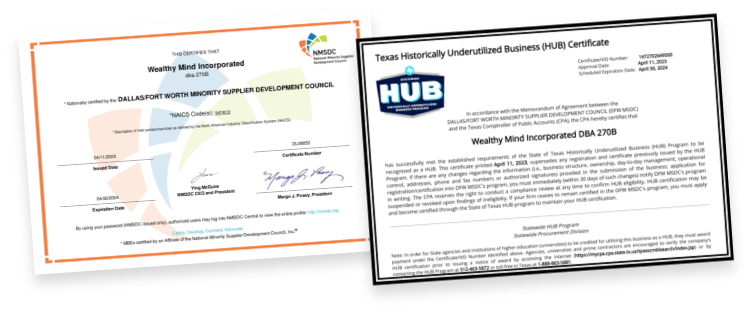
 270B is a minority-owned business
270B is a minority-owned business

and part of the National Minority Supplier Development Council Inc.



DIGITAL EXPERIENCE AGENCY

A History of Sustainable Considerations
The Oxford English Dictionary defines sustainability as
1. “The ability to be maintained at a certain rate or level.”1
2. “Avoidance of the depletion of natural resources to maintain an ecological balance.”1
The conversation about sustainability began in the late 1980s when a UN-commissioned study, The Brundtland Report, defined it as people’s ability to “meet the needs of the present without compromising the ability of future generations.”2 In 1994, strategist and entrepreneur John Elkington incorporated sustainability in his Triple Bottom Line business model composed of profit, people, and planet – the “3 Ps.”3 Elkington theorized that only businesses that considered their impact on all three financial, social, and environmental aspects of their brands would be successful.3 This vision incentivized brands to use economic, social, and governance (ESG) policies because the strategy provided them a framework for measuring sustainability for the first time.4
The early adoption of ESG focused on ways to change operations to increase profits and quantitative goals.5 Positive outcomes were vital to rationalize the changes and retain investors.5 Brands’ new ESG policies included carbon emissions, deforestation, waste management, diversity and inclusion, and fair labor and pay, which were also compelling narratives for consumers because the programs supported “doing good.”5,6 Since these missions required prolonged dedication, yearly improvements could only accomplish limited results.
A decade later, pundits Peggy Lui and Alan AtKisson claimed that “sustainability [was] dead” and Advertising Age called sustainability jargon.2 The sentiment was that sustainability was a futuristic ethic, not a tangible trend that companies could use to increase profits.2 Industry leaders also suspected burnout and negative sentiment towards the term, since most people believed that protecting the planet was too aspirational.2
When the sustainability conversation resurfaced around 2015,* it was driven by a small group of consumers and contained aspects of both conversations from the 1990s and the early 2000s. These Lifestyle of Health and Sustainability (LOHAS) shoppers were “focused on health, fitness, environment, personal development, sustainable living, and social justice.7 LOHAS consumers wanted products that supported their lifestyle and consequently valued brands that not only promoted organic and non-GMO labels, but also included traceability and information about how the products were created.8 They wanted to know that the brands they purchase from were upholding their claims in their business models.8 For these consumers, ESG-led companies provided the quantitative data LOHAS consumers desired.
*The gap between “sustainability is dead” and LOHAS consumers was during peak mobile technology innovation, which brought the spike of social media use. It is possible that LOHAS consumers existed earlier but did not have enough of a voice without social media to make an impact. Alternatively, data may not have supported why consumers were choosing products and brands with traceability over others.
In 2020, the COVID-19 pandemic accelerated ESG consciousness. On an individual basis, health and sustainable living were at the forefront for consumers, and 60% from a 2020 global survey by Accenture reported making environmental, ethical, and sustainable purchasing choices because of the pandemic.9 Their behavior reflected the sentiment by shifting to local or small business shopping and 90% said they planned to continue shopping with this mindset because “it is important that climate change is prioritized in the economic recovery after Coronavirus.”9
For businesses, the ESG focus at the start of the pandemic was twofold because they experienced consumers’ demand for ethical practices and convenient digital solutions at the same time that supply chains were disrupted.10, 11 This crisis highlighted the need for companies to find alternative operations solutions.10,11,12 Brands responded by evaluating their sourcing, manufacturing, and distribution of supply chain processes and then innovating by integrating ecommerce and sophisticated artificial intelligence (AI) tracking that allowed brands to better predict trends and avoid running empty trucks and conveyer belts.10 AI also reduced bottlenecking by stagnant ports, air, and rail transportation.10
According to a 2022 McKinsey survey, nearly 60% of brands “have adopted new supply-chain risk management practices” from necessity to bypass tangled supply chains.12,13 The shift has forced brands to “ensure business continuity by building resiliency and flexibility,” making the brand model more sustainable.12,13 Brands that are leveraging their new processes are earning an average of 11% more than their competition.10
As an added benefit, newly digitized brands have inadvertently embraced ESG responsibilities.10,11 Industry leaders are noting the correlation of independence from supply chains with the resulting carbon reduction and brand transparency, calling it essential for company operations.10,12 When examining its own company, Business Insider noted that “these issues are more than a trend — they are the part of a corporation’s license to operate.12
The complex relationship between company operations and environmental, social, and governance initiatives has called for a new approach to sustainability that pundits consider more encompassing.5 Corporate Social Responsibility (CSR) is filling this definition by considering a brand’s internal mission and values simultaneously with the brand’s operations.5
Continuing into the 2020’s, establishing an integrated sustainability business model will be critical for success. The second part of this blog will investigate modern CSR.
1. https://languages.oup.com/research/oxford-english-dictionary/
2. https://www.huffpost.com/entry/a-brief-history-of-sustai_b_12787800
3. https://www.economist.com/news/2009/11/17/triple-bottom-line
6. https://www.npr.org/sections/money/2019/09/17/761312221/does-it-pay-for-companies-to-do-good
7. https://www.sciencedirect.com/science/article/abs/pii/S0959652619320256
9. https://www.bbc.com/news/business-55630144
10. https://www.businessinsider.com/sc/why-a-sustainability-strategy-is-critical-to-sales-in-2023
11. https://www.businessinsider.com/sc/the-role-of-corporations-in-shaping-the-new-esg-landscape
12. https://www.weforum.org/agenda/2022/01/5-ways-the-covid-19-pandemic-has-changed-the-supply-chain/
13. https://www.cnbc.com/2021/10/18/supply-chain-chaos-is-hitting-global-growth-and-could-get-worse.html